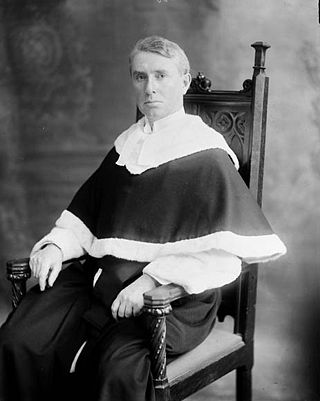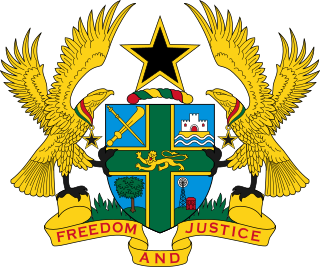
The Supreme Court of Canada is the highest court in the judicial system of Canada. It comprises nine justices, whose decisions are the ultimate application of Canadian law, and grants permission to between 40 and 75 litigants each year to appeal decisions rendered by provincial, territorial and federal appellate courts. The Supreme Court is bijural, hearing cases from two major legal traditions and bilingual, hearing cases in both official languages of Canada.
The Canadian order of precedence is a nominal and symbolic hierarchy of important positions within the governing institutions of Canada. It has no legal standing, but is used to dictate ceremonial protocol.
An administrator in the constitutional practice of some countries in the Commonwealth is a person who fulfils a role similar to that of a governor or a governor-general.

Beverley Marian McLachlin is a Canadian jurist and author who served as the 17th chief justice of Canada from 2000 to 2017. She is the longest-serving chief justice in Canadian history and the first woman to hold the position.
Claude Wagner was a Canadian judge and politician in the province of Quebec, Canada. Throughout his career, he was a Crown prosecutor, professor of criminal law and judge.

Sir Lyman Poore Duff,, PC(UK) was a Canadian lawyer and judge who served as the eighth Chief Justice of Canada. He was the longest-serving justice of the Supreme Court of Canada.
John Charles Major is a Canadian jurist and was a puisne justice on the Supreme Court of Canada from 1992 to 2005.

The chief justice of New Zealand is the head of the New Zealand judiciary, and presides over the Supreme Court of New Zealand. The chief justice of New Zealand is also the chief justice of Tokelau. Before the establishment of the Supreme Court in 2004, the chief justice was the presiding judge in the High Court of New Zealand, and was also ex officio a member of the Court of Appeal of New Zealand. The office is established by the Senior Courts Act 2016, which describes the chief justice as "senior to all other judges".
A deputy of the governor general is, per the Constitution Act, 1867, one of any individuals appointed by the governor general of Canada, with the Canadian monarch's consent, to act in their stead, exercising any powers so delegated to them by the governor general—generally all save for dissolving Parliament, granting royal assent, signing orders in council, issuing royal proclamations, or receiving the credentials of newly appointed ambassadors to Canada.
Judicial appointmentsin Canada are made by the federal government or provincial government. Superior and federal court judges are appointed by federal government, while inferior courts are appointed by the provincial government.

The chief justice of Ghana is the highest-ranking judge of the Supreme Court of Ghana. The chief justice is also the head of the Judiciary of Ghana and is responsible for its administration and supervision. In order of state precedence, the chief justice is the fourth highest official in Ghana.
The chief justice of the Democratic Socialist Republic of Sri Lanka is the head of the judiciary of Sri Lanka and the Supreme Court of Sri Lanka. Established in 1801, the chief justice is one of ten Supreme Court justices; the other nine are the puisne justices of the Supreme Court of Sri Lanka. The post was created in 1801. The chief justice is nominated by the Constitutional Council, and appointed by the president. The first chief justice was Codrington Edmund Carrington. The 47th and current chief justice is Jayantha Jayasuriya.
In Australia, a lieutenant-governor is a standing appointment for a deputy governor of a state, who acts in place of the governor if the governor is unable, unavailable or unwilling to act.

Richard Wagner is a Canadian jurist serving as the 18th and current Chief Justice of Canada since 2017. He previously served as a puisne justice of the Quebec Court of Appeal (2011–2012) and of the Supreme Court of Canada (2012–2017). For several months in 2021, following Julie Payette's resignation as Canada's governor general, Wagner was the administrator of the government of Canada as well as chief justice.

The 2020–2021 Rideau Hall workplace review was an external review by Quintet Consulting of the workplace culture at Rideau Hall—which hosts the governor general of Canada and her staff—initiated by the Privy Council Office (PCO) following allegations of harassment and verbal abuse by Governor General Julie Payette and her secretary, Assunta di Lorenzo. The review ultimately produced a report in January 2021 concluding that Payette and Di Lorenzo presided over a toxic work environment, resulting in their resignations on January 21.
The administrator of the Government of Canada is the title used by the individual performing the duties of Governor General of Canada – the federal viceregal representative – while the office is vacant or its incumbent is otherwise unable to perform his or her duties. The office is defined in the Letters Patent, 1947, which created the office of Governor General in its present-day role. Should it be necessary to fill the position, the chief justice of Canada may act as the administrator, followed by the puisne justices in order of seniority should the chief justice not be able to assume the role. Accordingly, the role is a temporary one meant to serve only during a vacancy in the governor general's office, and is not a title that is consistently held by the chief justice at all times. It is invoked under the terms of a dormant commission.
























